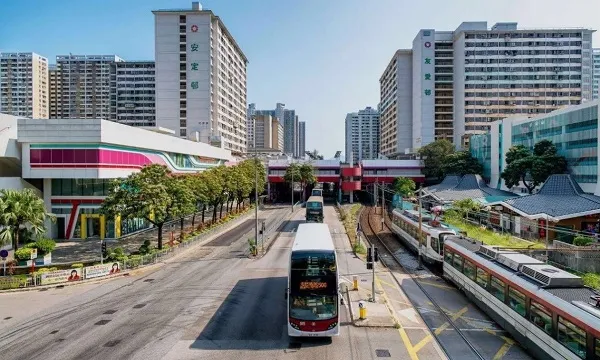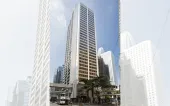
Neighbourhood malls and flex spaces prop up weakening property market
Lesser-known neighbourhood malls are cashing in from a more stable source of income and product mix.
As the freewheeling days of the Hong Kong property market come to a close, the office segment is gradually proving to be a resilient asset class in the ongoing downturn especially as decentralisation continues to gain momentum.
With Central holding the title as the world’s priciest office market at around $2,641 psf in rental costs - eclipsing that of New York’s Midtown and London’s West End - cash-short tenants are increasingly considering more cost-efficient alternatives for their office needs. In fact, a study by Colliers found that two in five (41%) office occupiers across the island considering relocation upon their next lease termination.
“Grade-A office market, leasing momentum in Central has been dampened by market uncertainties while Kowloon’s leasing market is relatively active,” David Ji, director and head of research & consultancy for Greater China and Hong Kong at Knight Frank, told Hong Kong Business.
Photo source: CBRE
By submarket, Island East occupiers have expressed more likeliness to relocate. This, according to Colliers International, could be reflective of the fast rental growth over the last few years, which has provided cost-conscious companies with an incentive to move. On the other hand, occupiers in Kowloon and the New Territories expressed that they are more likely to remain in their present location, reflecting their satisfaction in the area given more affordable rents and limited options for cheaper locations. Average rents in Kowloon and the New Territories have only edged up a mere 4.7% and 1.4%, respectively, in the last three years—the same time it took for average rents in Hong Kong Island to jump 14.3%, data from Colliers show, indicating a wide rental gap.
Those with relocation plans said that they want to move within the same district (54%) or relocate to other districts (46%), whilst some said that they prefer to relocate to the core CBD areas of Central and Admiralty (21%). The study noted that tenants currently staying in the fringe CBD (Sheung Wan/ Wan Chai/ Causeway Bay) have indicated plans to relocate to the core CBD. Kowloon East is another popular location option amongst occupiers with relocation plans, with half of that relocation demand coming from outside the Kowloon East submarket.
To lure tenants, landlords have been turning to additional on-site amenities, according to Colliers. “Landlords offering the facilities in greatest demand should attract anchor tenants into their properties,” the firm said. Meeting rooms or event venues, gym rooms or cafés and green buildings facilities have emerged as the top three amenities which catch the attention of occupiers.
The new CBD?
Resident CBD tenants have started to set up headquarters in Island East, thanks to the Central-Wan Chai Bypass trunk road and its traffic-light-free long tunnel which slashes travel time from 15 minutes to five minutes. Big ticket names like Facebook, EY, and Baker McKenzie have taken the lead in setting up shop in Island East and even the Securities and Futures Commission is reportedly relocating from Central to Quarry Bay.
“These relocations demonstrate companies are increasingly paying attention to Island East over Wan Chai/Causeway Bay. With the travel time from Central being slashed dramatically, Island East’s strengths as a relocation destination with high quality offices and low rents are revealed,” Colliers International said in a report. Furthermore, the decision by large corporates to open their headquarters in the area should help cement Island East’s as
a leading business hub for companies from the professional services, TMT, insurance and financial sectors, which form the most important business sectors in Hong Kong.
Office supply in Island East is set to witness rapid growth with 1.7 million sqft GFA of new office space set to come online by 2022, Colliers data show. This will account for 57% of the future supply on Hong Kong Island over the next three years. “In North Point, K11 ATELIER King’s Road from New World Development and 218 Electric Road from Henderson Land, are set in to bring an additional 500,000 sqft of Grade A office space to the area in 2019. As Island East becomes more competitive, its rental level should eventually catch up, narrowing the gap with other districts on Hong Kong Island. CBD tenants who remain hesitant should make a bold move before the rental savings diminishes and the availability of space in Island East disappears,” the research firm noted.
Island East’s well-established Grade A office portfolio and the prestige of being located on Hong Kong Island have been the area’s two major advantages over Kowloon East. Furthermore, despite the similar number of licensed restaurants and similarly sized retail market, the population density in Island East is only half of that in Kowloon East. This lower density provides Island East a better opportunity to focus on office development and establishing a sophisticated business community.
Kowloon is shaping up to be one of the frontrunnersfor the next Central especially with the widely anticipated commercial site that will open on top of the West Kowloon Express Rail terminal. With area of approximately 5.96 ha, the site will be home to three office towers providing up to 3.21 million sqft, with 2.8 million of office space, making it bigger than the International Financial Centre complex (2 million sqft) and the International Commercial Centre (2.3 million sqft). The commercite site is not just the largest in the 2019-2020 land sale programme, but also the largest of its kind in recent decades, a report from Knight Frank show.
Photo source: CBRE
With lower rental costs, the tenant mix in Kowloon has changed. Where financial firms once avoided the area, only looking to it to house its back-up operations, more companies have decided to relocate their Hong Kong Island front office to Kowloon. In 2016, banking and finance accounted for just 26.58% of major occupiers in the central part of Kowloon, a figure that rose to 35.23% in 2018 as the area now counts Citibank and JPMorgan amongst its big-ticket tenants, data from Knight Frank show. In TST, more Japanese and Taiwanese banks are also expanding their front-office operations.
Co-working boom
Hong Kong has seen the expansion of coworking spaces, as the total space occupied by the sector in 2018 expanded 35% to 613,000 sqft of the 1.62m sqft of total office gross take-up space in the island, data from Colliers show. Moreover, a record 900,000 sqft of new flexible workspace has been transacted. With 150 centres all over the island, an average desk costs $946 per month (US$121), a lot lower compared to the $5,790 (US$741) psf per annum average Grade A rent in one of the world’s most expensive property market. That said, the price tag is still higher compared to the $664 (US$85) average coworking desk rate in Singapore.
“The overarching trend was landlord sentiment softening towards flexible workspace. Whilst landlords remain conservative, most major landlords are now open to leasing space to the right operator, with Hysan, Sun Hung Kai and Swire Properties all increasing their exposure to flexible workspace over the year,” said Sayaka Matsumoto, Hong Kong associate director at Colliers International.
Amongst flexspace operators, US-based WeWork has been the most aggressive in growing its portfolio after securing spaces in four new locations in Hong Kong alone —an 84,000-sqft space in LKFT Tower in Central, a 60,200-sqft space in Lee Garden One at Causeway Bay, a 54,000-sqft space at Cityplaza Three in Taikoo Shing, and a 32,866-sqft space in Hysan Place at Causeway Bay. In total, WeWork occupies a total of 505,000 sqft in Hong Kong by the end of 2018, data from Colliers revealed.
On its part, local operator Campfire added two locations in Quarry Bay, expanding in their Wong Chuk Hang location and securing a new multipurpose space in Hung Hom. Another local player, Garage Society, added two locations in Sheung Wan and Wan Chai.
Similarly, The Executive Centre sealed its place as the leading premium operator in Hong Kong by adding Prosperity Tower and Champion Tower to their portfolio.Other premium operators are also trying to disrupt the market, including The Great Room which entered Hong Kong with a lease of one floor in Swire’s flagship development One Taikoo Place, and PRC operator Atlas which opted to set up their first location in West Kowloon, taking up space in Gateway.
Photo source: CBRE
There are an estimated 10 to 15 other major coworking players across Hong Kong, with close to 50 smaller operators running similar flexible workspace setups in the city. Despite the sector’s rapid growth, the year may prove to be a challenging one. “2019 is expected to be slower in terms of operator takeup. However, WeWork are expected to continue expansion with an estimated 650,000 sqft in their pipeline, and with operators from UK, Europe and the US looking at the market, we expect take-up to remain robust,” Matsumoto said. The flexible workspace sector is slated to account for 30% of Hong Kong’s property market in the next 10 years, from the current 3%.
Demand for such spaces has diversified from cash-short to startups to deep-pocketed multinational corporations in dire need of space as they continue to grow their teams and roll out innovative products. In September 2016, finance giant HSBC rented more than 300 hot desks at WeWork’s Tower 535 location to house its digital and transformation teams, whilst Standard Chartered designed and created its own innovation lab, eXellerator, to house its new business unit SC Ventures.
“In terms of why multinationals are doing this, it’s because there’s a lot of uncertainty in the market,” Michael Glancy, director of Hong Kong Markets at JLL, said. “Having an element of flexibility within a real estate portfolio, whether its 5% or 10%, can allow firms to contract and expand easily without either taking more space, lease liabilities and capex.”
The future is in the neighbourhood
Investors have also been pooling cash into a relatively underrepresented retail segment as tourists from the Mainland hold back on their spending in response to a weakening macro-environment. From late 2014 until early 2018, high street shop rents dropped more than 40% as visitor arrivals started to fall, leading retail trading conditions for high street shops and prime shopping centres to become increasingly volatile due to their reliance on visitor spending. Amidst this setting, a segment that used to be overlooked has become increasingly attractive for investors who have already injected $63b (US$8.06b) to the segment over the past decade. Neighbourhood malls, which only clinched 8% of retail investments in 2009, has secured 63% of total investments by 2018, according to a JLL report.
“As the potential capital appreciation is narrowing over time for acquiring premium and regional malls in Hong Kong, investors are seizing the opportunities to invest in neighbourhood malls whose operations are steadily supported by community demand of daily necessities. It is believed some of the neighbourhood malls would generate higher revenue through asset enhancement works, eventually raising their investment potential,” Knight Frank’s Ji said in a statement.
Local neighbourhood malls are more reliant on spending by Hong Kong residents, which has proven to be far more stable than tourist spending. JLL believes it is no surprise that domestic spending on retail goods is far less volatile, thanks to increasing wages and falling unemployment rate. “This is one of the major reasons why investors remain keen on opportunities in neighbourhood malls as landlords can be confident that their tenants can withstand fluctuations in the inbound tourism market. In addition, there is an expectation that luxury retailing, which typically drives prime shopping centre and high street rental growth, will not rebound over the medium term,” the research firm said in a report, noting that investors come from a mix of local, global, regional private equities and sovereign wealth funds.
The recorded higher volumes of investment is partly driven by the decision of Link REIT, the governmentbacked and largest owner of neighbourhood malls in the city, to sell parts of its portfolio. The average monthly unit rent in Link REIT’s retail portfolio has more than doubled to $65.7 psf in H1 of FY 18/19 from $30.6 psf in FY 09/10, data from JLl show. “These results significantly outperform other retail assets over the same period, including prime shopping centres (+41.8%) and high street shops (-9.9%).
In addition, neighbourhood malls typically provide a yield premium over other real estate asset classes, which is attractive to investors,” the report explained. JLL estimates that by the end of 2018, market yields for neighbourhood malls ranged between 3.0-4.5%, well above the city’s high street shops (2.5%) and Grade A offices (2.7%).
Photo source: CBRE
Even the product mix offered in neighbourhood malls is arguably more stable, with non-discretionary products that include supermarket goods and food and beverage, which have proven their resilience during tough economic conditions. In 2009 following the Great Financial Crisis, retail sales in supermarkets grew by 3.4% for the year, a strong performance compared with consumer discretionary categories such as clothing and footwear, which declined by 0.8% over the same period.
As neighbourhood malls mainly serve local residents, it could certainly get an uplift in retail demand from an increase in residential population amidst the significant supply of new private and public homes. JLL noted that the top areas that will see the most sprout in new residential supply between 2018 and 2022 include Cheung Sha Wan/Sham Shui Po, Tuen Mun and Shatin.
“The population of Cheung Sha Wan/Sham Shui Po is forecasted to increase by just over 70,000 people by the end of 2022. JLL estimates that the new households that move to Cheung Sha Wan/Sham Shui Po could spend an additional $180m per month on non-discretionary items, with a large amount of that being spent in the area,” the firm explained.



















 Advertise
Advertise






